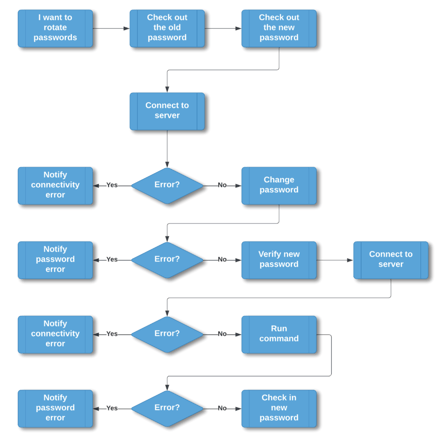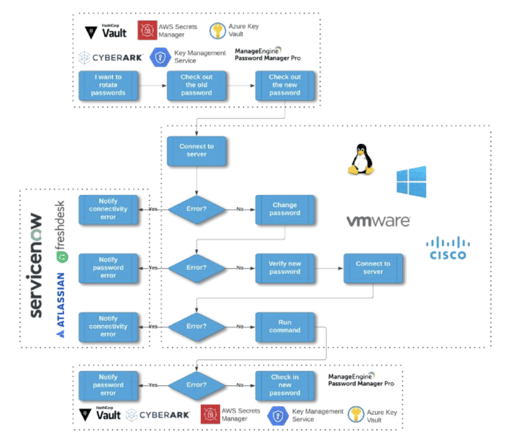Password Rotation Simplified: Why Event-Driven Workflows are the Key to Increasing Efficiency

Throughout the workday, most IT engineers spend 32% of their time on non-value-add activities. Administrative duties, such as meetings or operational tasks, take up meaningful time that IT engineers should spend on innovation, design, or development. What’s one task that requires too much of your time and effort? Let us guess… password rotation. 🤢 Be honest—you cringe every time you get pinged to change the passwords of your 100+ API integrations as each of the 30 or 60-day time period rolls around, right? We get it. Luckily, there’s a solution.
Creating an event-based workflow allows you to dedicate less time to password automation and more time to important tasks, such as writing new code or troubleshooting. If you’re an IT engineer, it’s time to discover how event-driven workflows can enhance efficiency and automate password rotation to increase your productivity (and sanity 🤪).
What are the Common Challenges of Manual Password Rotation?
While password rotation is a vital security measure, managing this manually slows down productivity and takes away from the time engineers can spend on value-adding tasks. With manual password rotation, you have to log into each system separately to change the password. This process also expands an engineer’s workload, which can potentially lead to burnout. Let’s dive deeper into the top three challenges of manual password rotation.
1. Manual Password Rotation is Time-Consuming
Rotating passwords manually can take days to complete, especially for companies with hundreds of API integrations. To complete this tedious process, you have to log into the API, access the settings, decide on a password, and log the password in a secure place. Then, repeat the process over… and over… and over again. 🤯 For example, say that a SaaS organization has 500 API integrations. With manual password rotation, an engineer has to access each app separately to change the password, which can eat up valuable time. It’s important to note that this long process may also interfere with other project timelines, such as putting off deployments for updates.
.webp?width=323&height=182&name=giphy%20(1).webp) (Source: Giphy)
(Source: Giphy)
2. Manual Password Rotation Can Lead to Manual Error
Generating passwords manually can also leave room for human error, like selecting a weak password or forgetting the password shortly after creating it. Manual errors can cause companies to perform password resets, which causes additional delays. On average, IT departments typically spend 2.5 months per year conducting password resets for various systems, apps or API integrations. Continuing with the example from above, if an engineer inputs a new password for 500 different API integrations, they may forget to log each password manually (or worse, log a password that’s incorrect by one digit 🙄. This forces the engineer to take additional time to reset the passwords they forgot or fix any errors they made.
 (Source: Giphy)
(Source: Giphy)
3. There is an Increased Chance of Security Breach with Manual Password Rotation
If engineers decide to wait to perform password rotation, they can put their APIs at risk of a security breach. Consider that the same SaaS organization as mentioned above requires that engineers perform password rotation every 90 days. Once the 90 day mark approaches, the engineers may not have the bandwidth in their schedule to devote several hours to manual password rotation. Instead, they make the decision to wait until the 120-day mark to change the passwords for their 500 API integrations. By doing so, the organization’s chances of becoming a victim of a security breach increase since hackers have a longer window of time to compromise the passwords.
What are Event-Driven Workflows?
A workflow is a series of events that are necessary to complete a task. With an event-driven workflow, applications can respond to an event in-real time, such as responding to user-initiated requests or reacting to a predetermined trigger. Once the trigger event occurs, it initiates the automated workflow to complete the sequences of steps to achieve the desired result.
Consider this example of an event-based workflow for password rotation:

The trigger-event for this workflow is the company’s need to rotate passwords, typically at the 60 to 90-day mark. The workflow then assesses the existing password for each system and connects to the server. After doing so, the workflow checks for errors. If there’s an error, the workflow notifies IT. If there are no errors, it successfully changes the password. Yes, it’s really that simple. 🚀
Overcoming Password Rotation Challenges with Event-Driven Workflows
By automating the password rotation process, your workflow can generate, rotate and secure thousands of passwords in seconds. With the right platform, you can enable the workflow to access previous passwords embedded in the local code, which keeps you from having to log each password manually. By using an event-driven workflow’s automated steps, you can lower the risk of manual errors, eliminate the time you spend on password rotation and ensure you have secure passwords for each system, app or API integration.

In a recent case study, an independent software vendor (ISV) that was using various tech solutions, including CyberArk, AWS Secrets Manager, and HashiCorp Vault, created event-driven workflows for automated password rotation using Direktiv’s open source software. By automating password rotation, the ISV saved 4 days per month of time and effort that engineers may have previously spent on manual password rotation. As a result, IT engineers use those additional 4 days of time to work on tasks that improve the business and their customer offerings.
Final Thoughts
Event-driven workflows are an excellent way to automate password rotation and save yourself a headache. Creating a workflow for password rotation allows you to:
- Boost productivity and engage in value-adding activities
- Enhance efficiency to simplify otherwise tedious tasks
- Strengthen your security measures to better protect your organization
It’s time to focus more on your value-add tasks, and leave the password rotation to the event-driven workflow. 🔥
Get started with Direktiv and create an event-driven workflow that meets all of your automation needs for enhanced password rotation.

.png)

